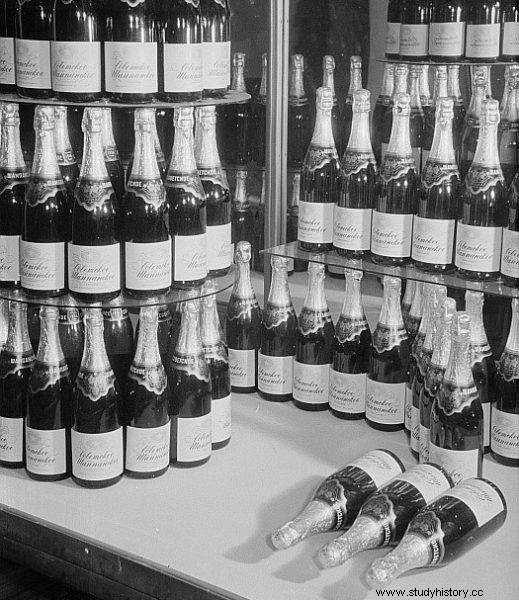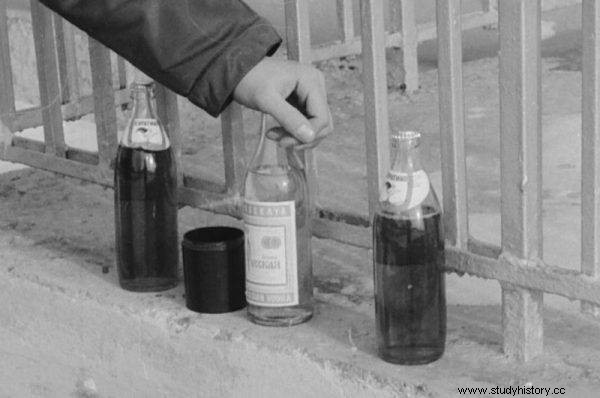Many Poles find it difficult to imagine a New Year's Eve party without it. Its popularity is best evidenced by the fact that there are tons of its fakes. Of course I am talking about white, sweet, sparkling wine, known as "Soviet" or "Russian" champagne. Few people know that there is a long history behind this drink. Joseph Stalin himself was supposed to dive his fingers in its creation ...
The extraordinary popularity of Soviet-made sparkling sweet wine was not a coincidence. Its origin and recipe were discussed at the highest levels of government. In 1924, Prime Minister Alexei Rykov came up with the initiative to create his own version of "champagne". In this way, the rulers wanted to prove that two years after the end of the bloody civil war (1917-1922), which claimed 12.5 million lives, life in the USSR is returning to normal.
Comrade Stalin cares for the working people
The head of government commissioned Polish specialists to develop inexpensive, high-quality wine that any Soviet citizen could afford. The production cycle of the drink was supposed to be short, which would translate into low production costs. This task was entrusted to Professor Anton Frolov-Bagriejew, who had been working "in the industry" since the tsarist times.
The scientist visited several wine producers in Western Europe, but decided not to follow his foreign experience. He created his own method of making wine - reservoir. The Soviet method of production differed from the Western one in that the champagne (sparkling) was carried out in 5 or 10 ton reservoirs, not in bottles. The whole process took about a month. Apparently, Stalin himself, a great wine lover, was involved in the creation of the Soviet champagne. The dictator was to test further Frolov-Bagriejew's proposals and choose - in his opinion - the best taste.

Soviet champagne immediately became the favorite drink of the citizens of the USSR. It was gaining in popularity every year.
In 1936, Frolov-Bagriejew considered the work completed. The Political Committee of the CPSU Central Committee decided to start the production of wine under the name of Sovetsky Shampanskoye. Anastas Mikoyan, a member of the Politburo of the CPSU Central Committee, praised the Soviet leader for his concern for the welfare of working people:
Comrade Stalin is committed to building socialism in our country. It deals with the entire national economy, not forgetting trivial matters, because every little thing matters. Comrade Stalin said that today labor leaders, workers and engineers have high salaries. And if they want to drink champagne, can they buy it? Champagne is a sign of prosperity and financial stability.
On a mass scale
In 1937, the Department of Spirit Products in Rostov-on-Don began producing champagne. The choice of location was dictated by the fact that nearby - in the Caucasus - there were numerous vineyards where the best grape species were grown. Initially, the production capacity of the Rostov plants was 500 thousand. bottles per year. By the end of the Soviet Union, this figure had risen to 24 million . Interestingly, only women have been working there for many decades. This is because the men were too much indulging in "tasting" so they were fired.
More monopoly enterprises appeared, incl. in Moscow, Leningrad, Kharkiv, Kiev, Minsk. Sovietskoye Shampanskoye gradually gained more and more followers. The then newsreels show how people dressed in work clothes drink it from ordinary aluminum cups. The widespread availability of the alcoholic beverage is evidenced by the fact that it was even sold ... in barrels.

In 1985, the production of sparkling wine and other spirits collapsed again. This time because Mikhail Gorbachev has announced an anti-alcohol campaign.
The outbreak of the Great Patriotic War slowed down the industry, but after the victory over Germany, the production of champagne resumed, and its popularity only grew. It also began to be exported. But before the first batch of goods reached the West, the Soviet side had to agree on the trade name of the wine with its partners. The problem is that the term "champagne" is reserved exclusively for sparkling wine made in Champagne . In order not to violate international trade regulations, the Russians agreed that the drink should be sold outside the Soviet Union as "Sovetsky Igristoye".
In 1985, the production of sparkling wine and other spirits collapsed again. This time because Mikhail Gorbachev announced an anti-alcohol campaign. It consisted, inter alia, of on rising prices of alcoholic beverages, introducing severe penalties for consumption in public places and limiting alcohol production.
As part of the fight against drunkenness, the authorities also ordered the destruction of vineyards, as a result of which 80,000 people disappeared in Moldova alone. with 210 thou. ha of crops. In 1985 and 1986, the citizens of the Soviet Union were therefore forced to celebrate New Year's Eve without their favorite champagne. After two years of the campaign, the rulers concluded that it was a mistake and withdrew from it.
Victim of decommunization
After the collapse of the Soviet Union, sparkling wine producers had to face the demands of the market economy. We managed not only to solve all the problems, but also to increase our production capacity to 220 million bottles per year.
The famous wine is also produced in Ukraine. In April 2016, the authorities of this country decided to remove the term "sovtskoye" (ie Soviet) from the name of the drink and replace it with "sovietovskoye" or "svetskoye". "The surprising effect of decommunization" - commented the decision of the ruling Internet users. Ukrainian champagne producers ensured that its quality would remain the same.
Bibliography:
- Documentary «Советское шампанское» (ATN).
- Wiernicka V. Secrets of the Soviet Union. Łódź, Księży Młyn, 2020.
- 3, https://echo.msk.ru/news/1688114-echo.html , access on 18/12/2020.
